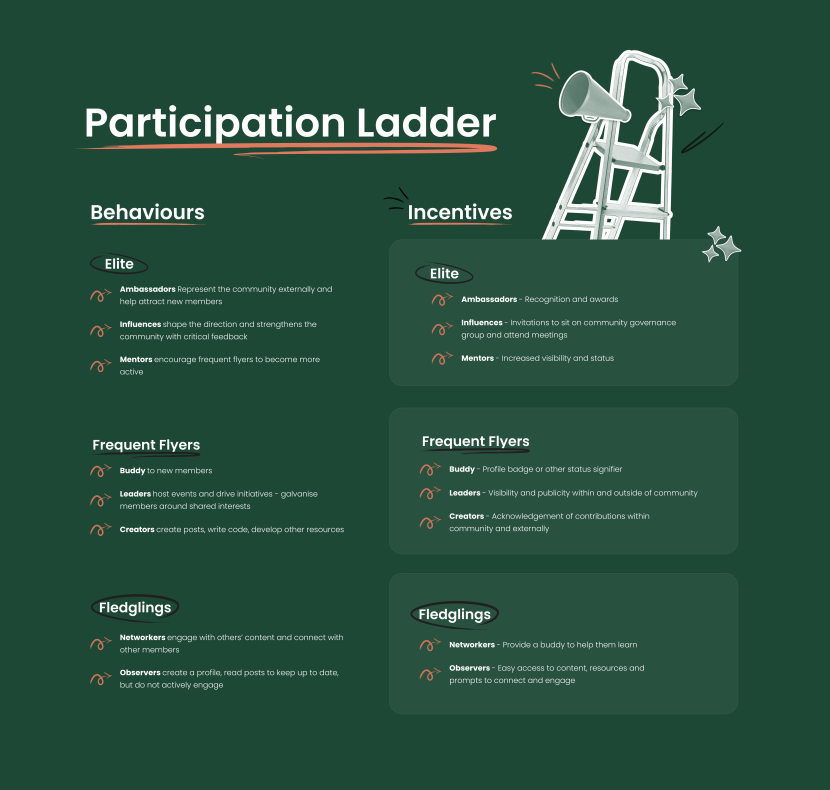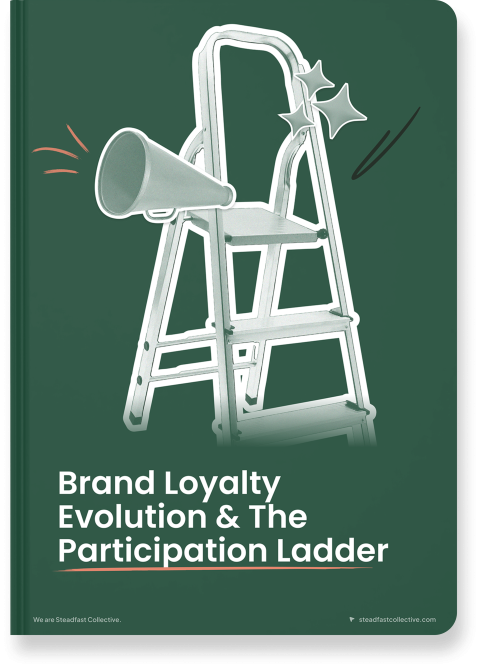Effective community design is crucial in the expanding landscape of digital communities. B2B brands and membership organisations are increasing their investment in online community building year-on-year (Thoman, K, 2023; Memberwise, 2024).
This growth trend is also evident in B2C brands that grasp the potency of word-of-mouth over traditional advertising (Neilsen, 2013) and the benefits of peer reviews and customer insights on tap (Zaglia, M, 2013). Online communities strengthen your endeavour and boost its success.
Intentional community building demands a structured strategic approach, combining a clear vision with activities that inspire, empower, and engage community members. Explore our Community Participation Ladder. It maps incentives that will lead to desired community member actions and aids in the design of community experiences and the development of new community-first business models.
Make your Community Participation Ladder by tailoring it to your unique community needs.
Incentives and Community Design
Incentives are vital in community building due to intense competition for people’s time and attention. In today's crowded media landscape, communities that add significant value to peoples' lives win attention.
Overcome this challenge by focusing on ‘what's in it for them’ (WIIFT). The Community Participation Ladder addresses the 1% rule (Arthur, 2006) by focusing on community member needs, ensuring content creation and contributions from more than just 1% of members.
Concept and Application
The Community Participation Ladder is a conceptual model aligning business goals with member needs. It addresses the challenge of moving members from low to high involvement, ensuring a healthy community where members feel a sense of belonging and ownership.
It is essential to achieving desired results and impact and is applicable to any community-first approach. It will help you plan how to operate your community and communicate member benefits.
When taking an omni-platform approach across multiple social and community spaces, think about how, when, and where your customers and fans will engage and design the experience accordingly.
The Community Participation Ladder
The illustrative participation ladder, pictured below, highlights desired member behaviours on the left and incentives to reinforce them on the right. As involvement increases, members progress from Fledglings to Frequent Flyers to Elites.
Explore the model by starting at the bottom left.

Fledglings in focus:
Initially, members explore their terrain before they take flight.
Guide them to create their profile and identify their interests.
Stimulate repeat visits with updates matching their interests.
Facilitate relationship-building through buddy systems and introductions.
Frequent Flyers:
These highly engaged members have lifted off. They regularly create content or run events.
They are motivated by profile elevation and interactions that closely align with their personal, career or business goals.
Empower them to support Fledglings and run their activities.
Elites:
Elites advance from Frequent Flyer status through sustained activity and impact. They are ambassadors, bringing in new members and influencing the community.
Strengthen their loyalty through appreciation.
Recognise their contributions with high-profile opportunities (e.g. in-person events) and exclusive programs.
Get to know your members. The more personalised the community member experience, the more likely it is to succeed.

Designing Your Community Participation Ladder
Our model is a springboard for your imagination rather than a prescription. Tailor your Community Participation Ladder based on insights into your members’ motivations, aligning it with your purpose and value proposition.
The best way to start is by integrating community insights and actions into personas and customer journey maps, ensuring community empowerment is built into rather than bolted on to the customer experience.
Gain insight from Personas and Customer Journey Mapping
Consider how community belonging and participation fit with your customers’ motivations, media habits, likes and dislikes, and current engagement with your organisation.
Work directly with your customers to understand their needs and map a new journey.
Customer journey stages may include awareness, interest, action (e.g., joining), onboarding, observing, involvement (e.g., helping others, relationship building, creating content), leading, influencing, and advocating. Create a seamless flow from awareness to advocacy.
Harmonise Your Ladder
Group members into participation categories (e.g. Fledglings, Frequent Flyers, Elites or your schematic) and create pertinent incentives for each group based on persona insights and the actions identified in your target customer journey maps.
Stimulate brand advocacy and recommendations by making engagement easy across various touchpoints. Think about what community features and integrations to include on your website.
Implementation and Effectiveness
The aim of the Community Participation Ladder is to increase community member participation. Consider how the incentives you might offer align with member motivations. Social proof typically works for consumer communities, while intelligence, networking, and recognition generate B2B engagement.
To boost participation, share specific information about participation opportunities during onboarding and throughout membership. Incrementally increase rewards to boost contributions.
Share real stories and testimonials from community members to inspire participation. Member stories show that the community is genuine and not simply a broadcast channel for brand communications and content.
Ensure seamless integration into operational procedures and track progress against community goals. Evaluate its success by analysing participation rates, member progression, and overall community impact on referrals and sales.
Consider how many Fledglings become Frequently Flyers and how many progress to Elites, how many member recommendations and referrals are made, and how many of them convert to sales.

Do You Need to Pay Active Community Members?
If you are creating a community where members pay a subscription fee, an increasing trend (Clark, 2019), be mindful that community leaders may ask for financial compensation for roles they have been asked to play.
Don’t shy away from conversations about pay. Rewarding active members with a paid role helps build loyalty and cohesion in your community. It will also help integrate new members and ultimately help your community scale.
Consider compensation for community management roles, recognising the time commitment and effort required. While financial incentives may not always be feasible, offer meaningful benefits. If you charge a fee to join your community, consider waiving it for active members to help make your community a success.
For existing employees taking on a community management role, integrate it into their job description and appraisals to ensure it is a priority.
Learning from Others
When designing your Community Participation Ladder, seek inspiration from various sectors, like the airline industry's loyalty programs, how retail brands collaborate with influencers and emerging community-first business models.
For example, the start-up community platform Koos.io advocates for a ‘fairer kind of business model’. With Koos, business becomes a community by ‘turning people who contribute to a company’s success into co-owners get a share in that success’. In the early days, koos.io smartly addressed the WIIFT conundrum. Similarly, Angelfish Opinions, a market research firm focusing on inclusive research, pays participants to participate in market research via online communities.
In contrast, Vitadoa.com, a community-owned collective, funds early-stage longevity research, generating revenue from its members to fund cutting-edge research. To date, its 10,000 community members have raised $20M to fund 20 projects. Vita DOA shows how decentralised blockchain communities may drive significant impact and innovative research alongside traditional institutions. There are many ways to build a dynamic and thriving community.
Do we expect everyone to move from how to high involvement?
No. Not all members will move through the stages. Moreover, member contributions may ebb and flow as priorities shift (Pfortmüller, F., 2022).
You may also have people who never comment or post but do pay attention to what happens every day. Sometimes known as ‘lurkers,’ these quiet members may be ardent fans and advocates for your community.
Therefore, it is important to recognise the value of all community members, regardless of their participation levels.
Conclusion
Crafting a bespoke Community Participation Ladder aligns member needs with relevant incentives, enhancing engagement and creating brand ambassadors.
Customise your Community Participation Ladder to maximise your community’s impact and foster long-term loyalty.
Getting your customers to help your business succeed is smart. Make it worthwhile for them to do so.
How will you design your Community Participation Ladder?
By Ann Longley
References
Arther, C, 2006, What is the 1% rule, Available at:
https://www.theguardian.com/technology/2006/jul/20/guardianweeklytechnologysection2 (accessed 11 January 2024).
Clark, D, Sept 2019, Harvard Business Review, Available at:
How to Create an Online Community That People Will Pay For (hbr.org) (accessed 11 January 2024).
Memberwise, Digital Excellence Report 2023-2024, Available at https://memberwise.org.uk/dx/ (accessed 10 January 2024).
Nielsen, 2013, Global Trust in Advertising and Brand Messages, Available at:
https://www.nielsen.com/insights/2013/global-trust-in-advertising-and-brand-messages/ (accessed 11 January 2024)
Pfortmüller, Fabian, Co-creation is crucial. But most communities still fail and rise with the leadership of a few, Jan 2022, [Available at:
https://medium.com/together-institute/co-creation-is-crucial-but-most-communities-still-fall-and-rise-with-the-leadership-of-a-few-e67e7610387e (accessed 10 January 2024).
Thomen, K., Brand Community 101: How Modern B2B SaaS Orgs Leverage Community to Fast-Track Growth, 18 Jan 2023, Available at https://peersignal.org/research/brand-community (accessed 10 January 2024).
Zaglia, Melanie E. Brand communities embedded in social networks, Journal of Business Research, February 2013.


